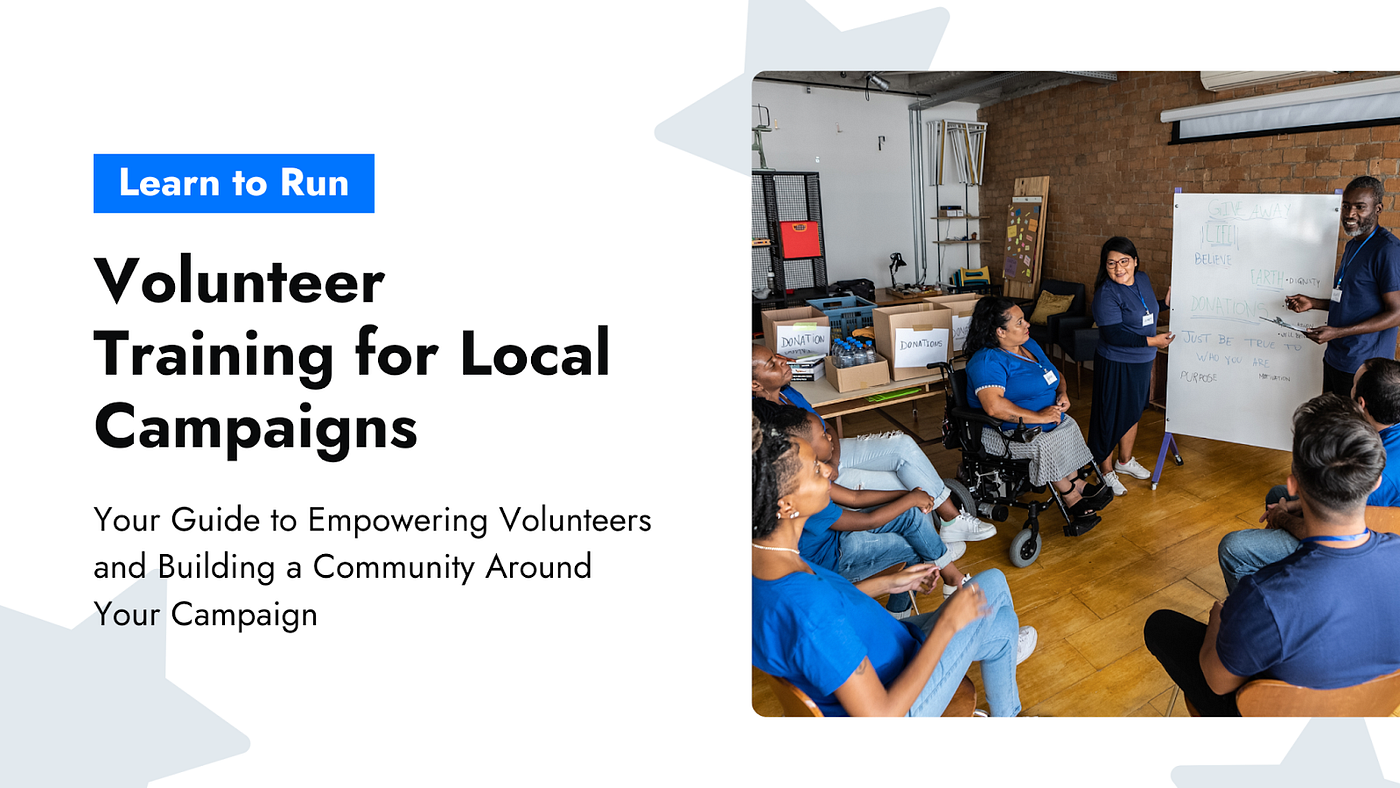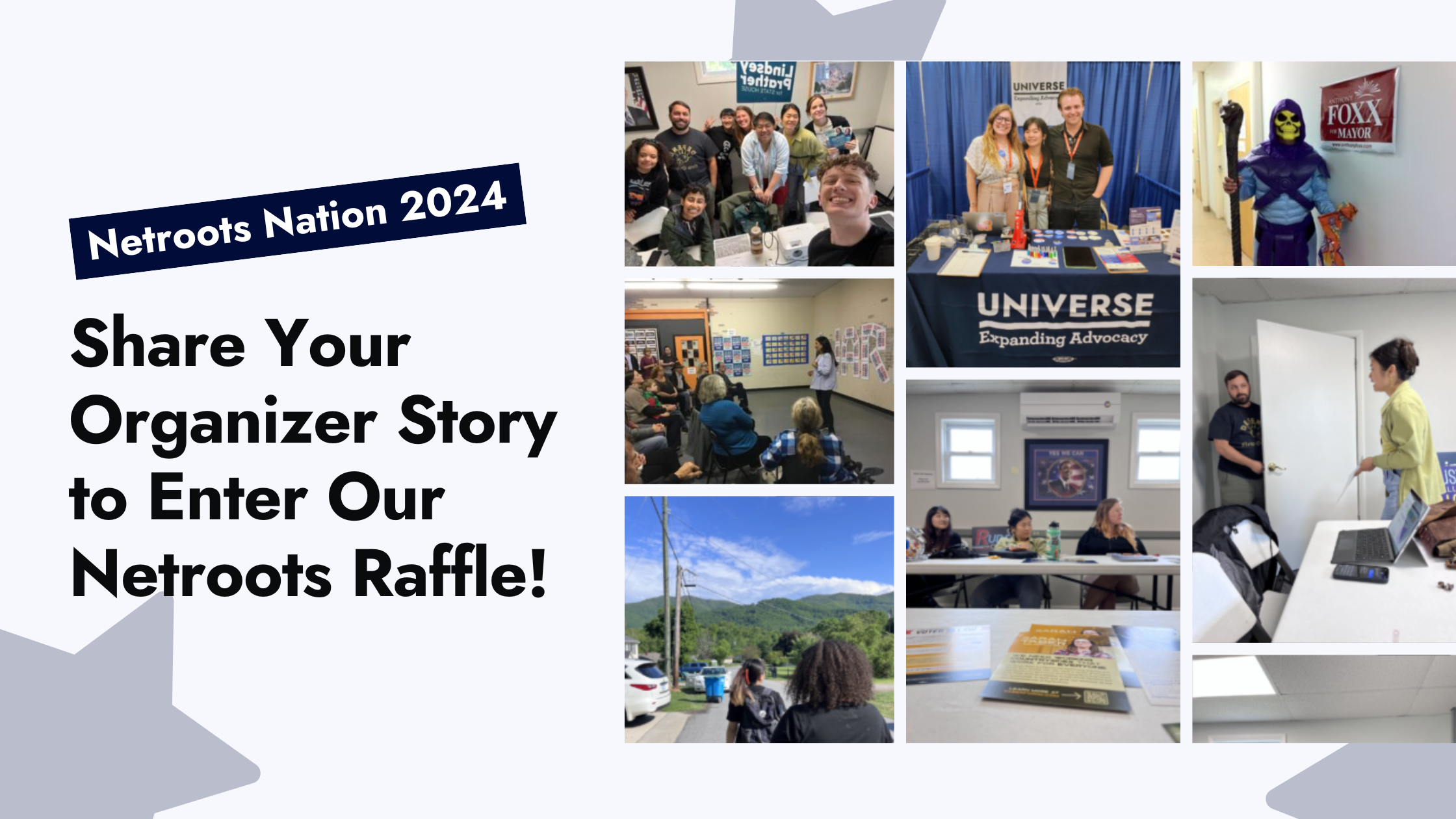Your Guide to Empowering Volunteers and Building a Community Around Your Campaign
Volunteers are the lifeblood of every political campaign. From phone banks to canvassing, they represent a candidate to the community. How you train, encourage, and retain your volunteers will be a sign of your success — so it’s critical to give them the tools they need to succeed.
You’ll want to invest in an effective volunteer training program so your dedicated supporters can help spread your message. Your volunteers should come away from training feeling confident, prepared, and ready to represent your campaign!
Note: You don’t have to do everything in this guide to have a successful volunteer training program. Choose what’s achievable and fits the culture of your team.
Here are our tips for training your volunteers and maximizing your campaign efforts:
Be Thorough
In most cases, volunteer trainings will happen before or at the start of their first volunteer shifts. Make sure you’re prepared by showing up early, preparing the content, and taking your time when going through the training.
You may want to jump right in to save time, but it’s important to give your volunteers time to introduce themselves, meet one another, and get acclimated. To some campaigning veterans, this may seem like precious canvassing time wasted, but first-time volunteers may be feeling out of their comfort zone at this point and community is at the core of what is value for almost all volunteers.
We promise — a longer, well-executed training program will pay off. This means reading through scripts, doing Q&A sessions, role-playing scenarios and situations, and being available to answer questions along the way — not rushing through training quickly so you can get back to campaigning.
Preparation Checklist:
- Select training method: Would you like to do this in-person, zoom, or document-only? (See next section for more on this!)
- Select someone to facilitate the trainings: Either a trusted, experienced volunteer, a paid staff member, or yourself.
- Create a timeline: Do new volunteers come early for training? Do you do a breakout room for new volunteers? How long will training last? Is it a one-off session or does it happen over time?
- Create a sample role-play scenario: Give volunteers the opportunity to practice phone banking, canvassing, and other voter outreach with one another. Scenarios may include a voter who doesn’t know their polling location, a wrong address, or other common campaign situations.
- Create a sample outreach: Make a phone bank/text bank/etc. with campaign staff in it so you can show volunteers exactly what they will be doing.
- Make space for volunteers to ask questions: Reserve at least 5–10 minutes at the end of training sessions in case people have questions. You can also encourage volunteers to ask you questions outside of training. First-time volunteers may be nervous or confused. By giving them space to ask questions or seek help, you’ll help build their confidence.
Consider Virtual Trainings
While you may be able to create a stronger sense of community in person, virtual training programs are more accessible to volunteers. They can easily be recorded and distributed. Also, by offering a virtual training option, volunteers have the leisure of learning from home on their own time.
Consider which makes the most sense for your campaign, or simply create a curriculum that applies to both and hold both types of trainings.
Preparation Checklist:
- Select your video chat provider (Zoom, Google Hangouts, etc.)
- Consider the format of a virtual training: Will you use breakout rooms? Will there be multiple facilitations? How will you deliver scripts to your volunteers?
- Make sure it’s effective: Track progress and make sure that volunteers are leaving training sessions with all the information they need.
Training Materials
Training materials can be a great way of informing and educating your new volunteers, and they save you some time. They should explain your volunteer program, your organization, and your goals. This can include presentations, handouts, or surveys.
Don’t overthink this — there will be plenty of time to update it with volunteer feedback. New volunteers will appreciate and use the training resources they receive.
Preparation Checklist:
- Create campaign overview presentation: This will be similar to the cheat sheet, but it will go more in-depth. Go over your candidate’s positions on key issues, the opponent, key demographics, and other campaign need-to-knows.
- Create volunteer follow-up emails: Include the dates for the next volunteer sessions and request feedback.
- Volunteer feedback survey (More on this later!)
- An FAQ page: This will be useful for new volunteers to reference during their first few shifts. This is also something you can build over time as you learn which questions pop up for new volunteers.
- Recorded training presentation: Volunteers can refer back to this if they’re ever confused about using your outreach tools.
- Contact sheet: Include phone numbers and emails of the organizers and campaign team in case volunteers need to reach them.
- A calendar marked with important upcoming events: This can include Election Day, GOTV, debates, and other similar events.
Volunteer Leadership Ladders
Look out for volunteers with high interest and commitment levels. If volunteers are excited about the cause, they will welcome new opportunities to get more involved.
Returning, enthusiastic volunteers are a wonderful asset to your campaign. They can gradually take on more responsibilities in the campaign, recruit their networks to also volunteer with you, or become donors.
Think about how you can encourage them. What steps can your campaign take to support them along the way?
Preparation Checklist:
- Track volunteer engagement: Note how many shifts volunteers are signing up for to determine your most engaged volunteers.
- Offer new opportunities: You can start by asking engaged volunteers to be mentors,recruit new volunteers, or even host the volunteer training sessions. You can also give highly-engaged volunteers the chance to ask for more responsibilities using forms or one-on-one time.
- Get to know your top volunteers: All of your volunteers bring unique skills and aspirations to your team. Maybe they can (and want to!) help you with graphic design, event planning, or training. The best leaders see the potential in their volunteers, and they creatively encourage them to go above and beyond.
Volunteer Retention
A common axiom in large campaigns is, “Volunteers come for the candidate, but they stay for the community.”
Your volunteers are spending their free time with you and your team. There are breaks between phone calls, long walks on canvases, and other bonding opportunities. Facilitating a community with your volunteers will pay off in the long run, and it will also make their work feel more meaningful and important.
Volunteering and working on a campaign can be really hard work, so camaraderie and community is valuable. It makes the tough times easier, and it brings everyone together as a team.
Ways to Build Your Volunteer Community:
- Plan social events: Depending on your bandwidth, this can be as simple as suggesting a pizza place or pub to go to after volunteer shifts. It can also be as elaborate as planning a thank-you barbecue.
- Encourage community Slack/communication channels: Use your Slack or other communication platforms to talk about more than volunteer shifts or poll results. Offer spaces where people can talk about what TV show they’re watching, the best place to get a bagel, or other topics.
- Use an ice breaker: At the beginning of a shift, ask everyone to introduce themselves to a few new people and say their favorite ____ (singer, sports team, super hero, etc.). It sounds simple, but it’s a good way to break the ice or give people the chance to say hi to someone new.
- Encourage mentorship: Ask top volunteers to mentor new team members. They can even just sit near first-timers so they’re available for any questions.
Don’t Be Afraid to Ask for Help
Remember to always ask your volunteers if you have a particular or unique need, because they may be able to help! Do you have a giant sign and need a big barn to put it on? Need extra granola bars to power your canvassing? Need a huge truck with an airhorn to help you march in the 4th of July parade?
You’d be surprised at the resources your volunteers have at their disposal. They’re just waiting for you to ask! Don’t forget to be respectful of their time, and always, always thank them for everything.
BONUS: Refine Your Strategy Using Feedback
As you recruit and train more volunteers, don’t be afraid to change up your process and curriculum. If you realize that a certain exercise doesn’t work, cut it! If there’s a gap in the curriculum, add it in. Each campaign has different needs, so don’t be afraid to refine your training program until it works for you.
Different stages of the election may also require different training. GOTV looks very different from initial fundraising. Make sure that your training is relevant to what is happening on the campaign trail so your volunteers can be as effective as possible.
Gather feedback from your volunteers to determine what’s working and what isn’t. Encourage volunteers to fill out these feedback forms by making them available or allotting time at the beginning or end of shifts. If you really want to increase your feedback responses, you can offer a small incentive like a piece of merch or a gift card.
Volunteer Feedback Question Examples:
- What would you say is the main reason you volunteered with us?
- Have you identified a need in our community that you think our campaign could address? Please explain.
- What do you enjoy about volunteering with us?
- Do you feel that you received enough training and information to feel prepared and carry out your volunteer work as effectively as possible?
- Please rate the training you received. (Very Helpful, Helpful, Neutral, Unhelpful, Very Unhelpful)
- Do you feel your volunteer work is significant or impactful? If you answered no, please explain how we can make your volunteer work more meaningful.
The volunteer experience is at the core of the Universe product. Keep your volunteers happy with user-friendly tools. Learn more.
Remind Volunteers Why They Joined the Campaign
If you are not the candidate yourself, tell volunteers about the candidate, or invite them to join a training. This way they can introduce themselves, talk about their platform, and develop a more personal relationship with their volunteers. Familiarize volunteers with what’s at stake and how your campaign will make positive change.
Volunteers should feel inspired and excited to be a part of your team. Make sure they understand how important their work is, the impact they have, and how much you value their time.
Preparation Checklist:
- Remind your team of their impact — Throughout the campaign, share your progress with the team. How many doors have you knocked on? How many phone calls have you made? It’ll remind volunteers that they are a part of something bigger.
- Invite the candidate to visit — It’ll mean a lot to your volunteers if your candidate personally comes in and thanks them for their work. It can be a really effective way to get everyone hyped up before a canvas or other GOTV efforts.
- Celebrate wins — Thank your volunteers and share good news. Volunteering can be so exciting if you’re following along with the positive progress of the campaign!
Choose a voter contact tool that prioritizes your volunteers’ experiences. Get a demo or sign up at universe.app/get-universe.
…


